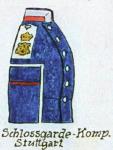-
Posts
2,234 -
Joined
-
Last visited
-
Days Won
55
Content Type
Profiles
Forums
Blogs
Gallery
Events
Store
Everything posted by Glenn J
-
Jay I checked the regimental history again and still no mention of him. However...when I checked Ancestry.de for the Bavarian Army Stammrollen, Herr Misthilger's documents are there and show him as a member of the Minenwerfer-Kompanie of the Infanterie-Leibregiment and indeed killed on 30 April 1918 at Kemmel. After recruit training he entered the Leib-Regiment in the 7th Company on 25 July 1916. He was transfered to the Minenwerfer-Kompanie on 16 July 1917. He was awarded the EK2 on 24 December 1917 and was promoted to überzähliger (supernumerary) Gefreiter on 28 January 1918. Regards Glenn
-
Hi Chip I would say the determining factor is the wear of the Überrock with white shoulder straps and the silver Tresse (as per the Prussian pattern for their Schloßgarde-Kompanie). The cypher is rather circular surmounted by a crown. See plate 156 of "Das Deutsche Heer" by Pietsch, Knötel and Collas and this below also from Piestch. Regards Glenn
-
Jay I checked the rather huge history of the Leib-Regiment; The Minenwerfer-Kompagnie was a regimental asset and not a part of 1st Battalion. There are no casualties in the entire regiment who suffered mortal wounds or who were killed in action on 30 April 1918. Six members of the Minenwerfer-Kompagnie were fatally wounded or killed on 29 April 1918. The nearest match listed of those is an Infanterist Johann Mittermeier who succumbed to his wounds on 4 May 1918. Regards Glenn
-
Theodor Sproesser does not explicitly give dates in his book but he states that in early July command of WGB passed successively from: 8. Reserve-Division to 187. Infanterie-Division and shortly thereafter: Bayer. 12. Inf.-Division. When the Bavarian Division was sent to Siebenbürgen in August, WGB then came under command of 222. Inf.-Division. Oberleutnant Rommal commanded 2. Kompanie. Regards Glenn
-

Rare uniforms
Glenn J replied to The Prussian's topic in Germany: Imperial: Uniforms, Headwear, Insignia & Personal Equipment
Kraus (Die Feldgraue Uniformirung) states that the permanent staff of the Unteroffizierschule Marienberg wore a red crown on the shoulder strap of the field grey uniform. Regards Glenn -

Rare uniforms
Glenn J replied to The Prussian's topic in Germany: Imperial: Uniforms, Headwear, Insignia & Personal Equipment
Thats very interesting! I have never seen a photograph of the Saxon Schießschule buttons in wear. The buttons were 2.05 cm in diameter and had the Saxon coat of arms. If the indivudual wore a Swedish Cuff, the normal smooth buttons were replaced by the two buttons with the coat of arms. The buttons were worn by graduates of and permanent staff of the Infantry School of Musketry and Foot Artillery School of Gunnery (Schießschulen). Also worn by NCOs and Privates attached to the Weapons Testing Commission (Gewehr-Prüfungs-Kommission). Regards Glenn -
Hardy, Friese is not an uncommon name and I have been looking through the Militär-Wochenblatt for a gazetting of a promotion to Leutnant in either Grenadier-Regiment Nr. 3 or Landwehr-Infanterie-Regiment Nr. 1. I have yet to find a suitable "suspect", although I have yet to index a sizebale chunk of both 1917 and 1918. I would have thought, that if he was commissioned, it would have been to the rank of Leutnant der Landwehr. Regards Glenn
-

Austria-Hungary Austria-Hungary - chip Oberleutnant Frankevych
Glenn J replied to Ruslan UA's topic in Austro-Hungarian Empire
Oberleutnant Konrad Frankiewicz of Ulanenregiment von Böhm-Ermolli Nr. 13 Fähnrich: 1 Sep 12 Leutnant: 14 Oberleutnant: 1 Nov 15 Regards Glenn -

EK 1914 Super Bombastic EK Docs....
Glenn J replied to Chris Boonzaier's topic in Germany: All Eras: The Iron Cross
Chris, pages 409 and 485. Regards Glenn -

EK 1914 Super Bombastic EK Docs....
Glenn J replied to Chris Boonzaier's topic in Germany: All Eras: The Iron Cross
Chris, according to the regimental history, he was commanding the Gefechtsstaffel presumably the regimental first line supply echelon. Regards Glenn




